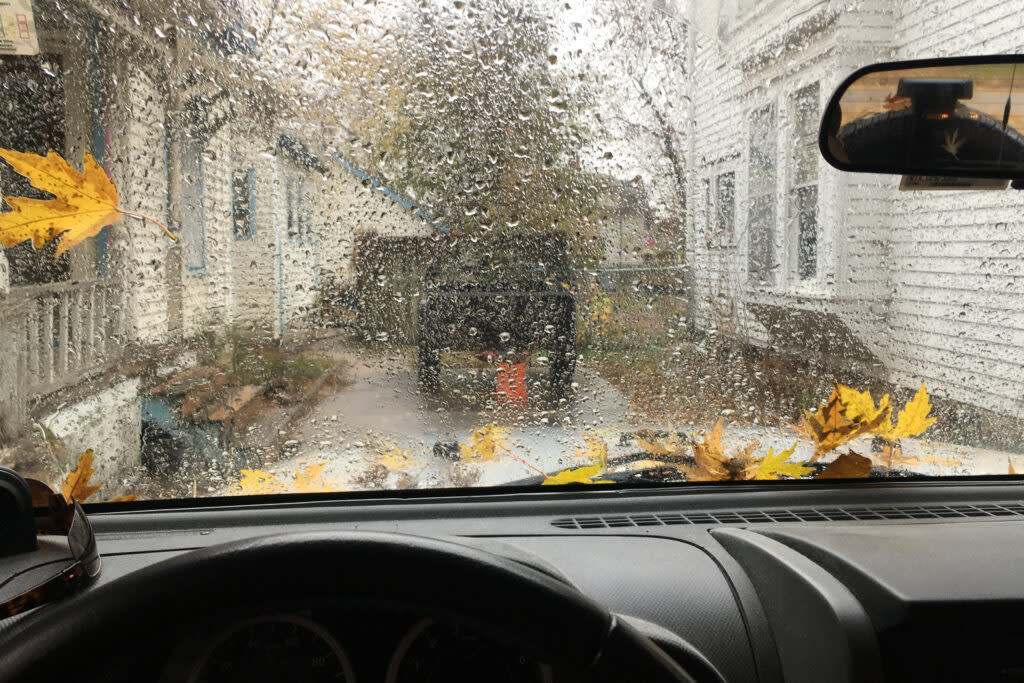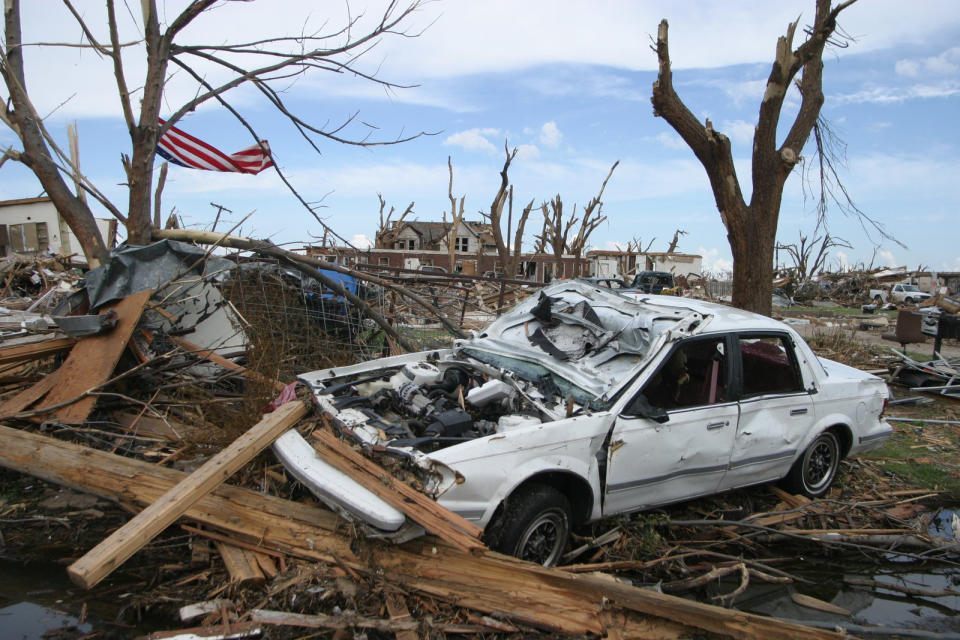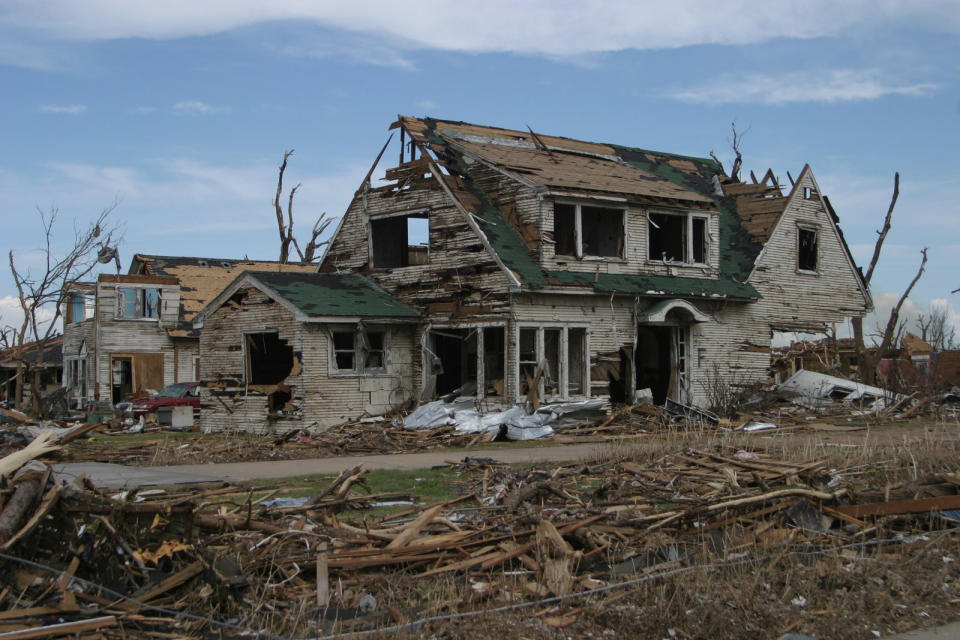AM car radios seem quaint. But when the twister comes, you’ll want that dial.

A rainstorm can be seen through the windshield of the columnist's Jeep in November 2023. (Max McCoy/Kansas Reflector)
When I read the Kansas House had overwhelmingly voted in favor of a nonbinding resolution urging Congress to require automakers to place AM radios in new vehicles, I gave a thought to the wind.
No, not that kind of wind.
I mean wind, as in actual weather, the kind of force generated by town-destroying EF5 tornadoes. Twisters are measured on the Enhanced Fujita scale, a yardstick for destructive potential that places EF5s at the top, capable of gusts exceeding 200 mph.
The tornado that destroyed Greensburg, Kansas, in 2007 and killed 11 people was an EF5. So was the one that chewed its way through Joplin, Missouri, in 2011, claiming 161 lives. It was the deadliest twister since the National Weather Service began keeping modern records in 1950. Both storms came in May — Greensburg on May 4 and Joplin on May 22 — and I witnessed the aftermath of each.
Greensburg was reduced to bricks and kindling. About a third of Joplin was destroyed, including the house where my grandmother had lived when I was a child, and in each community the pain was deep. Kim was in Joplin the day the storm struck to see her youngest kid graduate high school — this was a few months before we were married — and as soon as I learned the storm had hit, I threw some things in the Jeep and began the three-hour drive from Emporia. Kim and her children were fine, because they and other graduation attendees had ridden out the storm in a basement on the Missouri Southern campus, but I remember driving into Joplin that night, where some of the dead and injured were still in the streets, fires burned in spots, and the lightning-marbled sky promised continued bad weather.
I stayed in Joplin a few days to help out at my old paper. I’m not sure I was that much help to my former newsroom, but I felt I had to do something. During the day I would report. We (that is, me and Kim and her kids and a couple of former journalism students of mine) huddled in her house, which had suffered only a leaking roof. We were shaken by the storm sirens that went off periodically as the threatening weather continued, and we would listen for storm updates on a portable radio.
Having covered the wake of three major storms — Greensburg, Joplin, and Katrina in 2005 — I can tell you that expecting to rely on everyday things is foolish. You’re thinking about how much water you have and what kind of food is available and, if you’re on foot, where you might possibly charge your phone. Not that your phone will do you much good, of course, because cell coverage is likely down. There’s likely to be no electric power for lights or Wi-Fi routers or internet, and what you rely on for information are battery-powered radios, especially a NOAA Weather Radio, or the AM/FM deck in your car.
The aftermath of the May 2007 Greensburg tornado left much of the town reduced to bricks and kindling. (Max McCoy/Kansas Reflector)
AM radio gets a bad rap these days because it’s seen as outdated when compared to the modern smartphone. Some vehicle manufacturers, including BMW, Volkswagen and Tesla, have either already removed an AM radio option or plan to do so. AM radio reception is susceptible to electrical noise, which results in static, and consumer demand (except for a demographic we’ll discuss later) has softened. But the AM radio in your dashboard will bring you accurate weather information when other devices can’t. Your local AM station, especially if you live in a rural area, is likely to provide live severe weather coverage, and these stations often rely on trained storm spotters. This is the kind of coverage that local broadcasters do best, but we’re likely to forget about such an essential public service until the next storm season rolls around. Together with a NOAA weather alert radio, live coverage on a local AM station is a reliable source of weather information when the lights go out.
FM broadcasts are limited to the line of sight of the transmitter, which in flat country like Kansas typically means 30 or 40 miles. But the signal from an AM station can go much farther, especially at night, because it can be reflected from the atmosphere and go beyond the horizon. This is a simplified explanation, and there are many variables in radio propagation, but generally FM radio, which operates on much shorter wavelengths than AM, is blocked by any physical object in the broadcast path. It’s a static-free signal, and reproduces music especially well, but the trade-off is distance. An AM signal can be intelligible even if weak and scratchy. For a more detailed explanation of AM (amplitude modulation) and FM (frequency modulation), check out this primer from the University of Southern California Viterbi School of Engineering.
Commercial AM radio is about 100 years old. The first federally licensed station was KDKA in Pittsburgh, which went on the air in 1920. But experimental AM goes back a few years more, to inventor Reginald Fessenden. He may have been the first to broadcast voice and music over the airwaves when, on Christmas Eve 1906, he played a violin solo of “O Holy Night” and read from the Gospel of Luke to astonished ship crews in the North Atlantic who were expecting good old-fashioned Morse code. At least, that’s the way Fessenden described it in a letter years after the fact.
Marconi had sent the letter “S” in Morse code, three dots, across the Atlantic from Cornwall to Newfoundland in 1901. Soon after, ocean-going ships were being equipped with Marconi wireless equipment.
The first federal radio regulation came with the Wireless Ship Act of 1910, which required cruise ships carrying 50 or more persons or traveling more than 200 miles to have radio equipment and an operator. After the sinking of the Titanic in April 1912, Congress enacted a new law making it mandatory for ships to listen for distress signals and to have a federally licensed wireless operator on board. The Titanic was equipped with a wireless, and sent out an SOS as well as the older distress call CQD. The calls for help weren’t immediately answered, however, as operators on other ships had either gone to bed or were too busy sending private messages for paying passengers.
In 1927, Congress created the Federal Radio Commission (now the Federal Communications Commission) and declared that the airwaves were owned by the public at large. The FCC, created in 1934, continues to regulate broadcasters and technology companies today, including internet providers.
Neither the FCC nor any other federal authority has ever required radios to be installed in new passenger cars, but Congress seems poised to change that. The bipartisan “AM Radio for Every Vehicle Act,” introduced last year, calls for the Department of Transportation to require automakers to include the radios at no cost to consumers. Last month, the bill picked up the required number of co-sponsors to ensure passage through the U.S. House.
The reason the bill has such broad support is because AM radio is integral to FEMA’s Emergency Alert System, to be used in case of national crisis, and because conservative talk radio, the format once dominated by Rush Limbaugh, is such an important part of the rural political spectrum.
A smaller demographic would be those who listen to talk shows with a supernatural bent. I remember first catching Art Bell’s “Coast to Coast AM” radio program late at night on long drives to the Rockies and being fascinated by the weird content, which ranged from ghosts to conspiracy theories. The quavering, static-prone nature of AM fit the subject matter perfectly. I didn’t believe all that I heard, but it was entertaining.
That we are having a national discussion on the future of AM radio would likely have pleased the late Bell, an avid radio buff and for years a puckish figure on the fringes of mainstream entertainment. It also says something about the times in which we live that one of the few truly bipartisan causes we can agree on is the need for a public channel for emergency messages, just in case we need it.
I have to admit that I was a little shocked that I agreed with something our state lawmakers have done.
Yes, the Kansas House resolution was nonbinding and likely won’t have much effect on federal legislation, but still — House Concurrent Resolution 5026 passed 109-14, showing bipartisan support for an issue of public safety. The few naysayers, according to reporting by Kansas Reflector’s Tim Carpenter, were concerned mostly with “violating free market principles” by dictating to automakers instead of letting consumers decide.
But if we give the free market free rein, we’d still be driving around in fiery Ford Pintos or allowing 8-year-olds to smoke Camels.
A house was shredded by the May 7, 2007, tornado in Greensburg. (Max McCoy/Kansas Reflector)
Sadly, we can’t predict the next Greensburg or Joplin. But we can learn the lessons from these natural disasters. There is no bigger lesson than the importance of a reliable means to communicate with as many people as possible under the most difficult of circumstances.
The destruction of an EF5 storm is something that’s difficult to describe. With Greensburg, it was like the entire town had been run through a buzz saw, reducing houses to kindling and clipping the trees at just over head high. In Joplin, areas that had been familiar to me since childhood were pulverized, reduced to a debris field in which even the names of the streets had to be spray-painted on the asphalt.
The destructive force on display at both locations was something I had only seen before in photos of the bombings of Hiroshima and Nagasaki. It seems fitting now, because scientist Ted Fujita — inventor of the Fujita scale — was sent in September 1945 to investigate the effect of atomic bombings on trees and structures. His observations there of how vertical structures beneath ground zero tended to remain standing, while everything else was flattened, led him to an understanding of microbursts and other storm phenomenon. A meticulous and obsessive observer, in 1971 he created his method to rank a tornado’s destructive power. The Enhanced Fujita Scale, in use since 2007, is based on estimated wind speed and observed damage to trees and structures.
It’s easy to scoff at the idea that AM radio, a messenger from an antique land, is of any use in these days of smartphones and social media. But phones are only as good as their number of bars, and social media are platforms with inscrutable rules enforced by mysterious, anonymous and downright antisocial entities that won’t give adequate explanations for what they do. Unlike the broadcast spectrum, the internet is not owned by the public for the general welfare, but is instead treated by the FCC as public utility, sort of like a telephone company.
My belief in the effectiveness of AM radio comes from my own experience in New Orleans and Greensburg and that of Kim, who in the hours after the Joplin tornado, turned to the radio in the dashboard of her Ford Focus for information.
And if it seems I know a little more about radio than average, it’s because I’m a federally licensed general class amateur radio operator who got his ticket back in the day when you still had to know Morse code. I’m not fast at it, my best speed is only around 15 words per minute, but I can still send and receive. Apart from a hardcore group of radio amateurs who exchange messages on the shortwave bands, there’s not much call for it these days. Even the Coast Guard stopped listening for Morse Code in 1995.
There will come a day when a better technology to use in emergencies comes along than AM radio. But for now, it’s the best means we have of reaching people in disaster areas when public utilities fail.
That’s why an AM radio should be in every car.
Max McCoy is an award-winning author and journalist. Through its opinion section, the Kansas Reflector works to amplify the voices of people who are affected by public policies or excluded from public debate. Find information, including how to submit your own commentary, here.
The post AM car radios seem quaint. But when the twister comes, you’ll want that dial. appeared first on Kansas Reflector.



